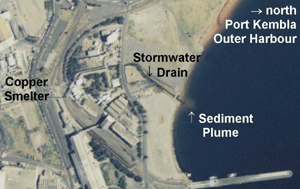The binding of arsenic in sediments of the heavily industrialised Port Kembla Harbour, NSW, Australia, has been investigated. Both dredge and core samples have been used to develop a sieving/sequential extraction (SE) procedure. Dredge samples included oxic surficial and deeper anoxic sediment. The main core sample analysed was 18 cm deep, sliced at 2 cm intervals. Sediment was sieved to three size ranges (<63 μm, 63–250 μm, >250 μm) and each of these was then subjected to a four step SE, sequentially solubilizing arsenic as ion exchangeable, 1 M HCl soluble, NH2OH·HCl soluble, and strong oxidising acid soluble. Concentrations of 50–500 mg As kg−1 were found, elevated well above local background values. The core sample showed elevated concentrations of arsenic within the top 6–8 cm (300–500 mg As kg−1), relative to the deeper sediment (100–200 mg As kg−1). Substantial portions of the total arsenic present in the 0–8 cm sediments of core and dredge samples, were found to be soluble in 1 M pH 5 phosphate buffer or 1 M HCl. Arsenic in the lower 8–18 cm of the core displayed different solubility, the fourth stage SE strong acid digestion being required to solubilize >90% of the deep sediment arsenic. It appears that diagenesis had resulted in remobilisation of weakly bound arsenic with subsequent diffusion and deposition in surficial layers. Strong acid soluble arsenic present in deeper sediments has two possible origins: sedimented as strongly bound remaining untouched by diagenetic events, or subjected to diagenetic reactions such as pyritization, which lead to more stable crystalline forms of minerals.


 Please wait while we load your content...
Please wait while we load your content...